Behind you. The development of circular vision technology for a vehicle creates new horizons
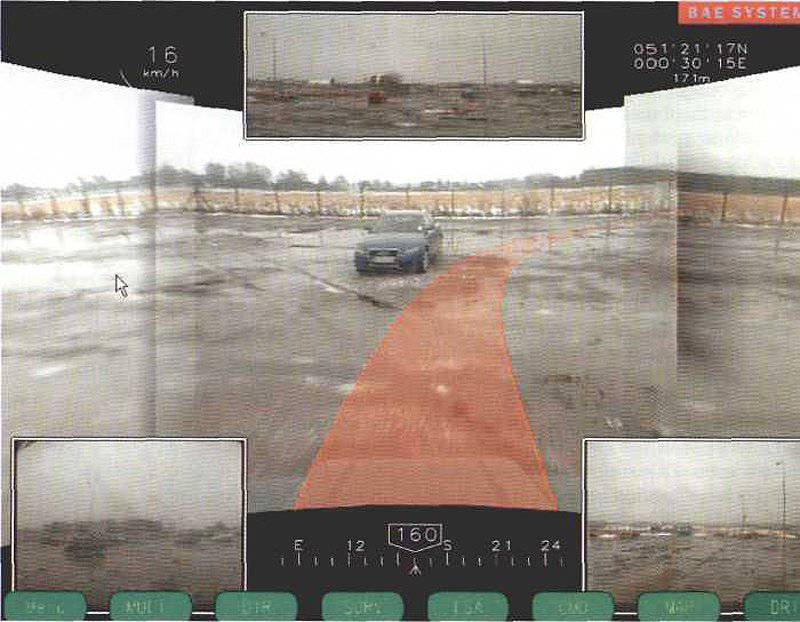
The driver display of the LATIS video system shows one of the options for how the Situational Awareness of the Ground Machine can be implemented. The image shows a combined front glass surface with three “docked” views: a central thermal image (projecting the vehicle's visible route), a rear view (copying an image from a regular rear-view mirror) and a view from the “wing mirrors” in each lower corner of the main display. It also displays the speed (top left), geographic coordinates (top right) and the course on the compass (bottom in the center). This composite image (and its elements) can also be shown to the commander and to any infantryman sitting in the rear of the vehicle.
The increased use of military vehicles behind closed doors and hatches in urban environments has led to an increase in the capabilities that are called Situational Awareness of the Land Vehicle (SIOM). In the past, SIOM was no more complex than the windshield, side windows and a pair of rear-view mirrors. The introduction of armored combat vehicles (BBM) into the urban environment and the threat posed by improvised explosive devices (IEDs) and rocket-propelled grenades (RPGs) led to the need to create new opportunities for peripheral vision.
SIOM systems emerged from an evolutionary process that has accelerated since about 2003 due to the realities of the war in Iraq and other war zones. And the process itself began with the addition of night vision to the vision and observation systems of drivers of armored combat vehicles (AFVs), which could theoretically participate in tank battles on the fronts of Central Europe. Night vision systems with image intensifier - II or I2 have opened the way for thermal and infrared observation devices.
In a closed car, the driver usually uses a periscope, while the shooter has a fire control system (LMS), including visual aids, and the commander has some kind of panoramic view. Although the technology has improved the range and resolution of these systems, their coverage (field of view) remains the same. When deploying troops against the regular army in 1991 in the Iraqi desert, the concept of European NATO operations remained unchanged due to the fact that the number of close battles in urban space was relatively small.
However, after the initial euphoria of the 2003 invasion of Iraq passed and a modern threat of asymmetric war arose, the crews of the main battle tanks (MBT) and other BBM (wheeled and tracked) were forced to fight in urban space. Driving through the narrow streets, the driver was unable to see what was happening on the side or behind the car. It was enough for only one person to secretly slip through the street and put something like a mine or another IED under the car and as a result it was immobilized or damaged.
Similarly, universal cars and trucks faced the same threats and were gradually further armored, while the protection certainly improved, but as a result, the visibility around the car deteriorated. Thus, they actually found themselves in the same tactical situation as the BBM. What these machines lacked was some form of circular or local (intra-zone) situational awareness LSA (local situational awareness).
Like many developments, LSA systems did not appear suddenly, but slowly evolved as the appropriate technologies appeared. The process began with the need to improve the driver's all-round visibility, which was reflected in the appearance of thermal imaging devices, as well as observation devices with increased image brightness. By the end of the 90-s, when a new generation of thermal imaging devices was introduced, the driver no longer needed to look at the periscope “observational” device, rather he was looking at a display similar to a television screen.
Driver's Vision Enhancer from Raytheon DVE AN / VAS-5 with a cooled long-wave infrared (LWIR - near [long-wave] IR spectrum; 8-12 micron) receiver for strontium-barium titanate, which has a matrix with a video cone of barium; 320x240 pixels in size, has a frontal field of view of 30x40 degrees and is a typical representative of such devices. (The US Army issued a contract in 2004 for manufacturing the bulk of DVE products to DRS Technologies, while in 2009, BAE Systems did get its share of their production).
In the UK, the introduction of thermal imaging began in 2002, when the DNE 2 (Driver's Night Vision System - dual channel device, driver night vision system - dual channel) from BAE Systems (currently Selex Galileo) was adopted for the Titan AVLB (Armored Vehicle -Launched Bridge - armored bridge laying vehicle), Trojan ETS (Engineer Tank System - engineering tank) and Terrier CEV (Combat Engineer Vehicle - fighting vehicle raking). It was also installed on the articulated BvS10 Viking all-terrain vehicles with additional bookings by British marines and some vehicles in the Netherlands.
Colin Horner, vice president of marketing and sales for Selex Galileo Land Systems, describes the DNVS 2 device as an forward facing forward armored unit mounted in front of the hull, which includes a color CCD camera (CCD charge coupled device) with field of view 64x48 degrees and thermal imager LWIR 320x240 (with field of view 52x38 degrees). The driver sees the image on the 8,4-inch color LCD display mounted on the dashboard. Subsequently, Ultra Electronics supplied day cameras to cover the tank flanks.
Later, the Caracal DVNS 3 device was developed. It has a wider field of view of 90x75 degrees for a CCD camera, as well as options for the color or monochrome version. Caracal was installed on the British Army's Advanced Armored Challenger XBTMB, Challenger ARB, M2B270 and M1B270 MLRS.
A graphic illustration of the module for tactical wheeled vehicles (DVE-TWV), included in the current generation of DVE-FOS systems. The module is a model AN / VAS-5C from DRS Technologies and is installed including on the HMMVW
TUSK develops
Since the US Army is forced to deploy an Abrams OBT in an urban environment, it has developed a TUSK kit (Tank Urban Survivability Kit - a set of additional equipment and reservations for the tank, enhancing its combat capabilities in urban environments), an integral part of which is the rear-view camera driver DRVC (driver's rear-view camera). DRVC is based on the Check-6 device from BAE Systems, it is equipped with an uncooled vanadium oxide microbolometer with an LWIR matrix 320xXNNXX (or 240x640) (originally developed for the thermal imager of the AN / PAS-480C model of the same company). The DRVC integrated into the rear end lamp of the Abrams tank was originally ordered in 13 and has since been installed on Bradley, MRAP (mine-resistant, ambush-protected) mine-proof machines and the Stryker family of machines. .
The exact composition of the TUSK kit for the Abrams tank, defined by its developer (above). An inquisitive reader will of course find differences by comparing the top and bottom photos, which show the TUSK kit.
In September 2009, the army command for electronic communications of each of the companies BAE Systems and DRS Technologies was awarded a contract worth 1,9 billion dollars (the so-called contract with an indefinite term and delivery quantity) for the production of an IR sensor system that would provide a 24-hour all-weather overview. for ground vehicles of the American Army and Marine Corps. The complex, known as the DVE-FOS driver vision systems family (Driver's Vision Enhancer Family of Systems), is a development of AN / VAS-5 DVE (although not a round-trip LSA system) and consists of four options.
DVE Lite is designed for long-haul trucks and tactical vehicles, while DVE TWV uses a panoramic module for tactical wheeled vehicles TWV (tactical wheeled vehicles). DVE FADS (Forward Activity Detection System - an advanced activity detection system) provides detection, monitoring and tracking of suspicious activity over long distances (for example, associated with installing VCA) and, finally, DVE CV (Combat Vehicles) is suitable for installation on combat vehicles. cars.
The availability of rear-view systems led to the introduction of repeater displays inside armored personnel carriers, and soldiers in the rear of the vehicle could see the situation from the outside before landing. This also in some ways led to a decrease in the number of claustrophobic attacks in the armored box and a decrease in the number of seasickness among the landing.
After getting the opportunity to have a front and rear view on the vehicle, a very short step remained - installing cameras and sensors on the body in order to reach the sides of the car and create a circular LSA. After which it became regarded as an essential requirement. Such systems have improved self-defense against nearby threats, allowing you to transfer targets to a combat module or use personal weaponby firing through the embrasures of the car. At the same time, these LSA capabilities reduced to a minimum the need for a landing force to immediately dismount in order to ensure safety around the vehicle.
In the UK, the first round-robin SIOM for the British Army was supplied by Selex Galileo for the Mastiff 2 6x6 armored patrol vehicles, which entered service in June 2009. This system, consisting of six cameras, has a forward-looking thermal imaging camera, a reversing camera, and two cameras on each side of the machine. “The requirement for visibility around the car was more a matter of maneuvering than of defining the threat,” said Horner. Similar systems have been delivered for the BBM Buffalo, Ridgback, Warthog and Wolfhound.
Due to the fact that ground movement, either in urban or in rural areas, has become the goal of an increasing number of IEDs installed under or near the known routes of convoys, it is virtually impossible to apply countermeasures directly to each such threat. As a result, a comprehensive deep hike was applied to solve this problem and many detection tools were tested.
Prior to the adoption of decisions on the near-field review, an early response to the need for SIOM and anti-IED devices was the rapid spread of the mast sets of sensors and sensors equipped with night and day cameras to many military machines. In those places where IEDs were installed, the soil around was broken and when viewed through the imager, there is a difference in the images of the “fresh trace” and the surrounding earth or concrete. These sensor units (heads) were mainly intended for aircraft, but they were “turned over” and installed on the machine's retractable mast, and were combined with a display / control panel installed inside the machine by means of a calculation unit. Currently, the crews have devices to determine the broken ground, which can serve as an indicator of the presence of IEDs installed ahead along the route.
In addition, at maximum descent, these kits gave the crew a very small amount of LSA. Full near coverage of the zone directly at the sides of the machine is impossible due to the shielding influence of the machine itself.
Different MRAP machines are equipped with a Lockheed Martin Gyrocam Systems optical sensor system installed on the mast.
Mast sensor
Typical of these systems is the VOSS (Vehicle Optics Sensor System), an optical sensor system for a vehicle, originally developed for the US Marine Corps by Gyrocam Systems (acquired by Lockheed Martin Missiles and Fire Control mid-year 2009) for the 360 program. The Marine Corps has requested a mast-mounted surveillance system for its MRAP-class vehicles, which will help detect roadside IEDs. In 2006, Gyrocam supplied 117 sensor units with ISR 100, each equipped with a medium-wave infrared (MWIR; 3-5 micron) thermal imager with a matrix 320x256; a high-resolution three-microcircuit CCD camera; single-chip CCD camera for low illumination and eye-safe laser illuminator; All devices of the opto-electronic system are placed in a turntable with a diameter of 15 inches (381 mm).
This program was quickly adopted by the US Army and became part of the work on demining and neutralizing explosive objects under VOSS. In May 2008, the US Army issued Gyrocam a contract worth 302 million dollars for VOSS Phase II with a potential volume of 500 units. The VOSS II optoelectronic station is based on a Gyrocam ISR 200 or ISR 300 using a high-resolution MWIR 640x512 thermal imager.
VOSS systems are installed on Buffalo, the Cougar JERRV (Joint EOD Rapid Response Vehicle), RG31 and RG33, all MRAP vehicles, were mainly used in Iraq and Afghanistan. Due to the fact that the company became known as Lockheed Martin Gyrocam Systems, the products ISR 100, 200 and 300 merged into one product line under the designation 15 TS.
FL1R Systems Inc, Government Systems (FSI-GS), with 2007, offers a mast optoelectronic station for ground vehicles based on a Star SAFIRE III turntable (Sea-Air Forward-looking Infrared Equipment). air application) diameter 15 inches. Sensor equipment, known under the designation Star SAFIRE LV (Land Vehicle), includes an MWIR 640x512 thermal imager; color CCD camera with zoom; color telescope CCD camera (long-range, narrow field of view); camera for low light; eye-safe laser range finder; laser porthole and laser pointer. FSI-GS also offers a similar version of its Talon station with a diameter of 9 inches with a similar set of touch equipment.
There is a wide range of sensors for incorporation into modern SIOM systems; virtually all of them are available in finished form and many are offered by suppliers of security equipment for the civilian sector. The list of companies and products is extensive, it is something like a “choose and mix” task, depending on the exact machine requirements, the time frame in which you need to make additional equipment and available financing.
Most of the cameras are traditional CCD models, available in a monochrome, color version and a low-light version (from the visible to the long-wave infrared region of the spectrum), whose lenses usually meet the requirements for a wide field of view. Many provide devices with high-resolution images, similar to commercial high-definition TVs, which is becoming increasingly important for unambiguous target recognition.
A family of ruggedized camera modules specifically designed for LSA applications and typical of such applications are supplied by California-based Sekai Electronics. The modules are supplied as either color or monochrome CCD cameras, in a sealed, EMI-protected aluminum housing with a scratch-resistant sapphire window, with fixed iris lenses of various focal lengths. The horizontal resolution of the cameras is> 420 lines, and the video output is NTSC or PAL (for color) and EIA or CCIR (for monochrome).
Likewise, thermal imagers are available on the market in various formats and configurations, which depend on the role and application. Thus, cooled and uncooled thermal imagers with LWIR, MWIR or shortwave (SWIR; 1,4-3 micron) detectors and 320xXNNXX arrays up to 240X1024 and more are available for consumers. Although some original equipment manufacturers (for example, FSI-GS) produce their own heat sinks integrated into their own products, others purchase receivers (detectors) from specialized manufacturers, such as the French Sofradir (specializes in cooled detectors with mercury-cadmium telluride technology) and its subsidiary ULIS (producing only uncooled systems).
For ULIS, the specific market SIOM is relatively new. The company's technical director, Jean-Luc Tissot, said that “ULIS has been supplying products for LSA applications for only a few years,” although the company's products were previously part of other systems for vehicles. Uncooled thermal imagers are basically less expensive and easier to maintain than used cooled receivers (detectors), and progress in image resolution has made them increasingly attractive. The company sells on the market three LWIR detectors (range from 8 to 14 microns) from amorphous silicon with 384x288, 640x480 and 1024x768 matrices and 17 micron pixel pitch to several customers, including Thales Canada.
Cameras and thermal imagers can be installed independently or in pairs, depending on the purpose. The Danish company Copenhagen Sensor Technology uses the Eurosatory exhibition to demonstrate its participation in improving driver's vision and creating systems for LSA vehicles, as well as sensor sets for combat modules and long-range surveillance.
The British Army Panther communications and control vehicle, equipped with a full set of TES. The front-view sensor is a thermal imager, and the Thales TES kit also includes the company's VEM2 module as a rear-view camera.
General Vehicle Architecture (GVA - Generic Vehicle Architecture)
In the early stages of SIOM development, most of the development work was carried out by specialized companies in response to the urgent operational requirements of users. Today we are considering a more structured approach due to the fact that the original systems developed for these urgent requirements are being improved. In the UK, for example, the Ministry of Defense gave such systems a higher priority, which led to the release of 20 on April 2010 of the Year Defense Standard 23-09 (DEF-STD-00-82), which describes the overall vehicle architecture (GVA).
Another British defense standard for SIOM systems (the 1 Intermediate version released in August 2009) is the 00-82 standard, "Vehicle Electronics Infrastructure Related to Video Transmission via Ethernet VI-VOE (Vetronics Infrastructure for Video Over Ethernet)". It establishes various mechanisms and protocols in order to facilitate the distribution of digital video over Ethernet networks, primarily via Gigabit Ethernet.
At Defense Vehicles Dynamics (DVD), held at the Millbrook test site in the UK, BAE Systems Platform Solutions (which brought together experience in image processing, integration and management of a British factory in Rochester with advances in sensor technology from the Texas plant ) showed the capabilities of LATIS (Local And Tactical Information System - local and tactical information system), integrated into the Panther machine in accordance with the GVA requirements.
Due to the fact that the systems quickly became “sensor-invariant,” LATIS is more of an architecture than just cameras. Program Manager for British Military Vehicles at BAE Systems Platform Solutions Rob Merryweather describes LATIS as a system offering: a driver display; use of intelligent characters; built-in training; motion detection and tracking; digital mapping; image combining; and the ability of automatic targeting and hitting targets on external target designation teams.
The company is involved in the GVA process and, according to David Hewlett, director of business development, initial efficiency, the basis of such systems as LATIS is “a scalable and flexible architecture with a large bandwidth of frequencies and low latency (delay)”.
The wait time is defined as the time elapsed from the moment when the photon enters the sensor head, to display the final image on the screen, measured in milliseconds. In order to get a system suitable for driving, you need a delay of less than 80 milliseconds.
Other elements of the LATIS project are displays (fixed and helmet-mounted, possibly using the Q-Sight display of the same company), processor and power requirements, plus control of such systems.
The Thales Group is also regularly present at the DVD show due to the fact that the UK unit has recently developed a new electronic architecture for a versatile machine. This architecture was created in order to comply with the new GVA standard of the British Ministry of Defense. Thales UK has been involved in determining the optimal GVA since the beginning of 2009, and demonstrated at the Challenger Architecture exhibition, suitable for use in advanced universal machines.
The architecture of Thales is distinguished by new software in order to improve the integration of multiple systems on board the vehicle. The functionality shown on the DVD included a generic man-machine interface for the GVA, providing built-in access to vision systems, sniper detection, power management, and operating status monitoring.
Real-time video distribution is based on another new defense standard (00-82 VIVOE). It includes a new line of digital cameras LSA, which are connected directly to the Ethernet data bus of this vehicle. Thales describes VIVOE as a “flexible, modular, or scalable configuration,” adding that, being digital, it “facilitates the use of auto-detection algorithms, target tracking, and many other image processing algorithms.” The overall result is improved efficiency and, therefore, increased vitality.
Canadian and UK subsidiaries of the Thales Group as key players in the vehicle architecture development process work together to leverage their LSA expertise to meet the specific requirements of the individual customer. The work of Thales deal with thermal imagers for drivers, including the imager driver TDS2 (Thermal Driver's Sight 2), digital amplifier vision driver's Driver's Vision Enhancer 2 (DVE2), amplifying module Vision Vision Enhancement Module 2 (VEM2) and a remote-controlled amplifier of vision of the driver Remotely Operated Driver's Vision Enhancer 2 (RODVE2), available in analog and digital versions.
“Starting in 2004, about 400 TDS devices were purchased for the commander’s version of the British Army’s Panther vehicle,” a Thales UK representative said. Before being sent to Afghanistan, 67 machines were upgraded to the Theater Entry Standard (TES) standard, including the addition of a rear-view VEM2 device (among other improvements) delivered as part of the immediate requirements in March – August 2009.
The addition of a thermal rear-view camera is currently standard for driver vision and surveillance systems. “When adding onboard cameras or providing a full view, the LSA system appears,” said a Thales Canada spokesman. Working together, Thales UK and Thales Canada supplied their first integrated local situational awareness system ILSA (Integrated Local Situational Awareness) for an unnamed buyer in 2008, and then another system followed for another buyer. This analog system consists of two RODVE cameras, six color cameras for low illumination, four 10,4-inch programmable LCD displays and an SDU (signal distribution unit) signal distribution unit.
Based on ILSA, Thales UK is currently promoting a digital version that is compatible with DEF-STD-00-82 and which will also comply with DEF-STD-23-09. In this open architecture, the VEM2 module is used for front and rear view devices, plus cameras, but essentially it is invariant to sensing components (sensors). When the field of view from 16 to 90 degrees in VEM2 applies uncooled receivers LWIR 640x480 from the French company ULIS. Thales describes this system as a “flexible, modular, and scalable configuration,” adding that the digital system “allows the use of auto-detection and tracking algorithms.”
Thales Canada currently offers LSAS (Local Situational Awareness System) local situational awareness system consisting of RODVE2 (also with LWIR 640x480 receivers) and VEM2, camera, SDU and human-machine interface. In addition, the company supplied various driver thermal imaging systems (RODVE2 and VEM2) for seven types of Canadian vehicles, including the Leopard 2 MBT, MXXUMX BTR, LAV and Bison machines, which have been operated in Afghanistan since 11.
Meanwhile, Colin Horrner of Selex Galileo reported that most of the company's work in the field of SIOM was financed with its own funds. At the Farnborough Airshow in 2010, the company showed a common LSA system. “Everything in it is designed to tailor solutions to the necessary requirements,” said Horner. In order to facilitate integration with existing machines, the system has its own functionality due to the display processing unit. Several display units can be installed in series inside the machine.
The emergence of developments in the field of LSA
In the US, Sarnoff Corporation develops systems designed for what it describes as “vehicle open space” and “vehicle closed space”. For the first category, Sarnoff created an image merging system for HMMWV car drivers; it used ordinary video devices and LWIR devices. The system offers an extended dynamic range and depth of field of observation for day and night driving. In addition, it has the capabilities of near observation, identification, detection and tracking. There is also a “circular situational awareness and understanding” for the automatic threat detection system, known as CVAC2 (Computer Vision Assisted Combat Capability), which is being developed by the US Marine Corps combat laboratory.
The CVAC2 sensor head consists of a fixed circular installation that accommodates 12 night cameras and 12 day cameras (installed in pairs one above the other). In addition, there are a pair of GPS receivers and panoramic platforms (with a circular field of view), an LWIR thermal imager, a day / night zoom camera, and a laser range finder. The system combines input signals from a number of different sensors through its Acadia I ASIC video accelerator in order to obtain a combined image.
The UK and the USA are not alone in the development of SIOM systems. In addition to these countries, Belgian Barco, German Rheinmetall and Swedish Saab are developing such systems.
The display manufacturer, Barco, offers a “rearview container” and a “panoramic container” as an LSA solution. In the company's literature, the latter is described as an open-digital system capable of combining up to eight cameras and compatible with the DEF-STD-00-82 standard. Methods of processing and "stitching" images allow you to present 180-degree and 360-degree panoramic views on one screen. Also integrated the ability to merge images and target recognition. The company confirmed the presence of one unnamed buyer.
Rheinmetall Defense Electronics presents a situational awareness system (SAS) for tanks with a circular azimuth coverage area (± 30 degrees in elevation). This is achieved by 4's three-touch blocks in each corner of the tower; The system was shown on the Leopard 2 MBT. The base sensing component is a high resolution daytime color video camera with uncooled thermal imaging receivers as an option. Displays have the “picture in picture” characteristic, as an option it is possible to introduce the function of switching to the target tracking mode in case of its detection by any element of the system.
The LSAS, developed by Saab’s defense and security solutions division, is based on six uncooled LWIR (7,5 – 13,5 microns) 640xXNNXX vanadium oxide microbolometers with FSI-GS Thermo Vision SA480 microbolometers, providing 90-degree surface coverage of the flanks and FSI-GS Thermo Vision SA270, providing the XNUMX-degree coverage of the flanks and the flanks and the cover of the flank and the body and the body and the body and the body and the body and the body and the world and the surface of the flanks and the surface of the flanks of the flank and the surface of the flanks and the surface of the flanks and the surface of the flanks and the surface of the flank and the body of the flanks and the surface of the flanks and the surface of the flanks and the body of the flanks and the cover of the flanks and the body of the flanks and the body of the flanks and the cover of the flanks and the body of the flanks and the covering of the flanks and the body of the flanks and the body of the flanks and the surface of the flank the quadrant is monitored by any driver thermal imager) and the proprietary video distribution system for real-time Video Distribution System of the same company.
At one of the air shows in Farnborough, the Israeli Elisra Electronic Systems presented the IR-Centric, which, although intended for installation on aerial platforms, has a similar application in ground systems. It uses an image processing system from existing infrared sensors of rocket warning systems (for example, the PAWS system of the same company) in order to get a panoramic image that can be displayed on the pilot’s helmet display. While MWIR detectors (receivers) require a minimum resolution of 256x256, wide-field optics and a large frame rate with a wideband channel, the secret lies in the SAPIR (Situational Awareness Panoramic infrared infrared) and display algorithms technology. Some BBMs have already installed infrared alarms for attacking missiles; such an application for ground-based machines is obvious, although such systems have not yet shown their capabilities.
Formerly considered as “non-mandatory capabilities,” driver surveillance systems have moved from BBM to support vehicles and, with the advent of new threats and technologies, evolved into full-fledged LSA systems. Opportunities, previously considered to be “nice to have,” are now considered an integral part of a land vehicle.
The situational awareness cameras included in the Rheinmetall modular upgrade package are installed on the Leopard 2 MBT
Materials used:
www.janes.com
www.raytheon.com
www.flir.com
www.ulis-ir.com
www.baesystems.com
www.elbitsystems.com
www.rheinmetall-defence.com
www.saabgroup.com
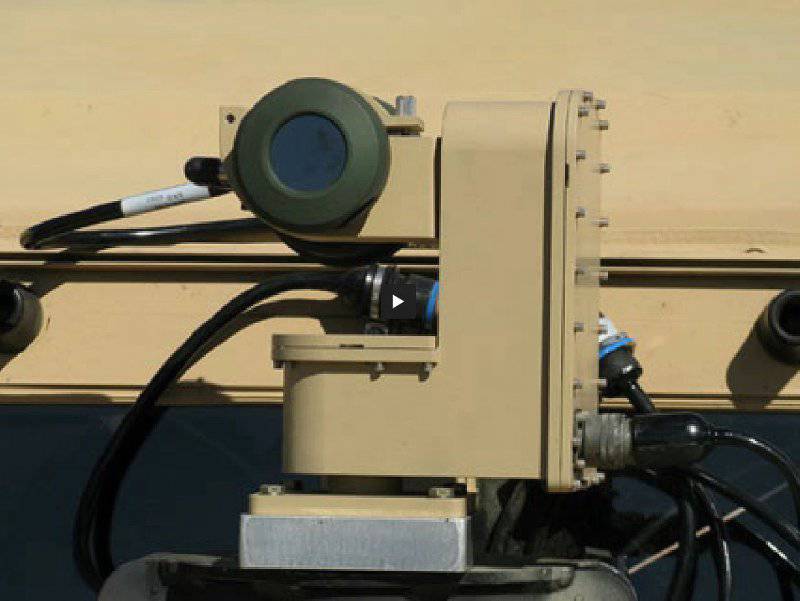
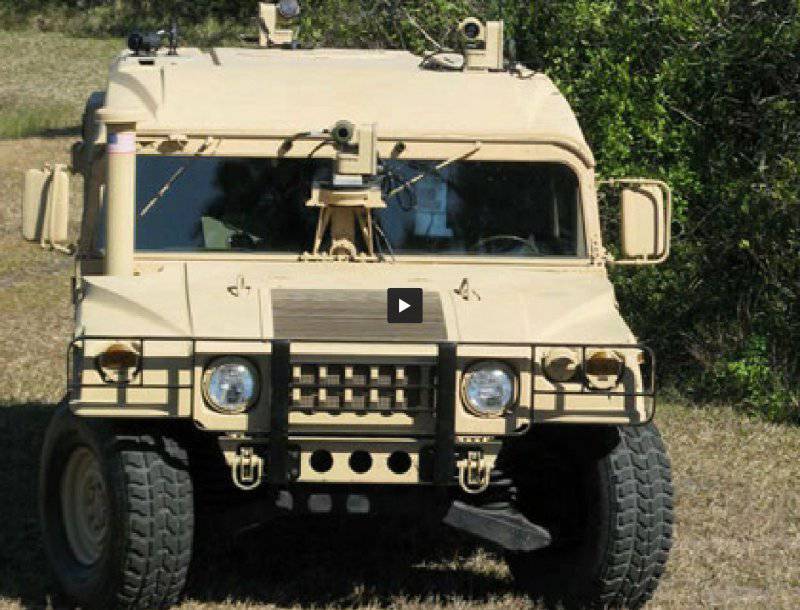
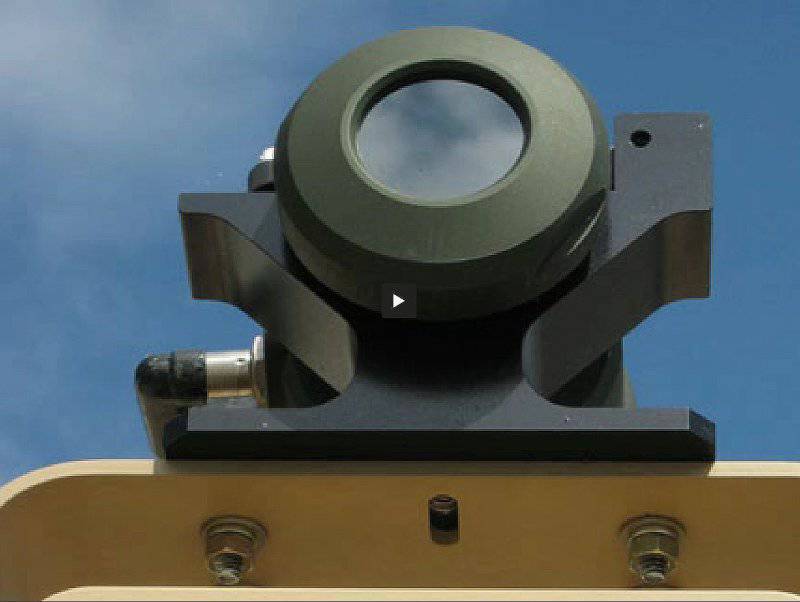
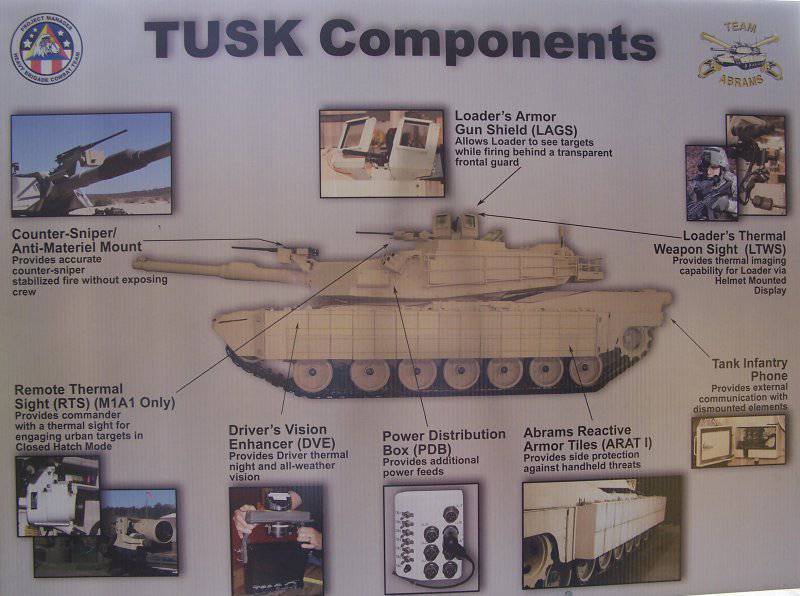
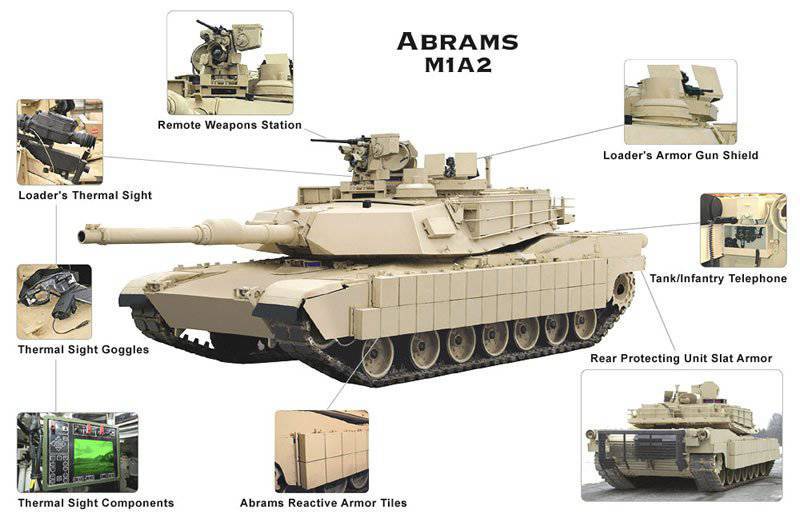
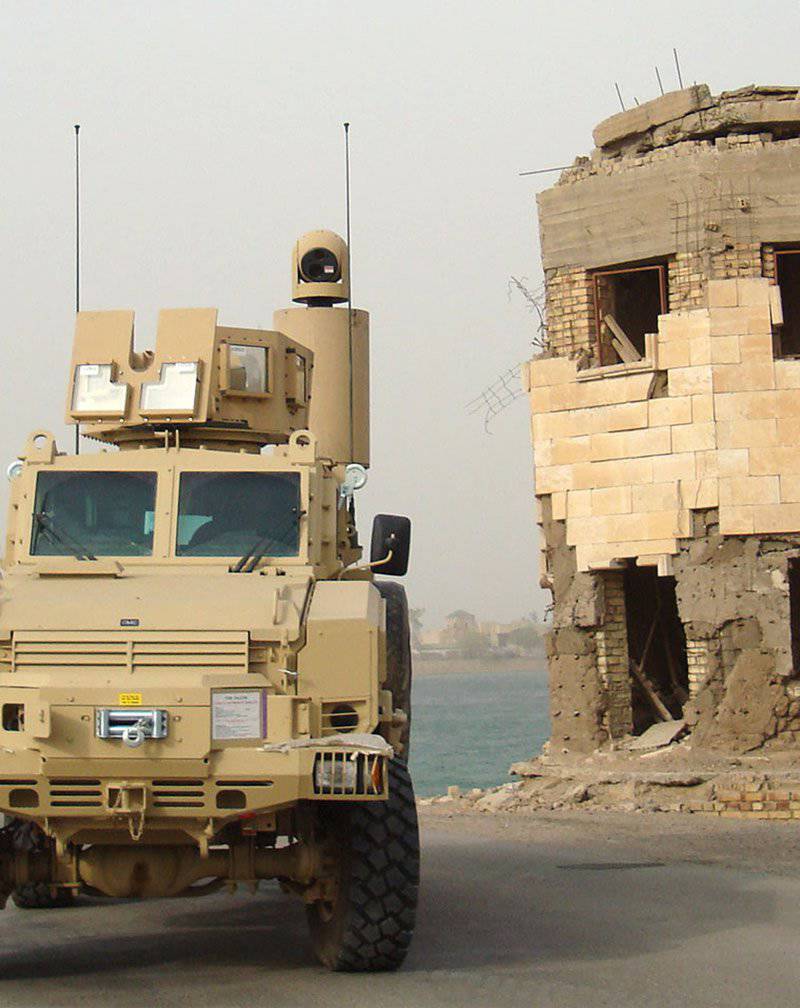
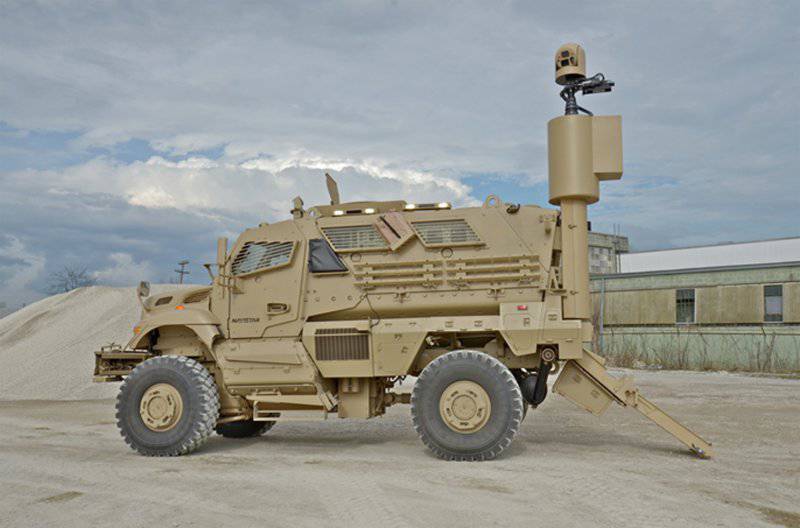
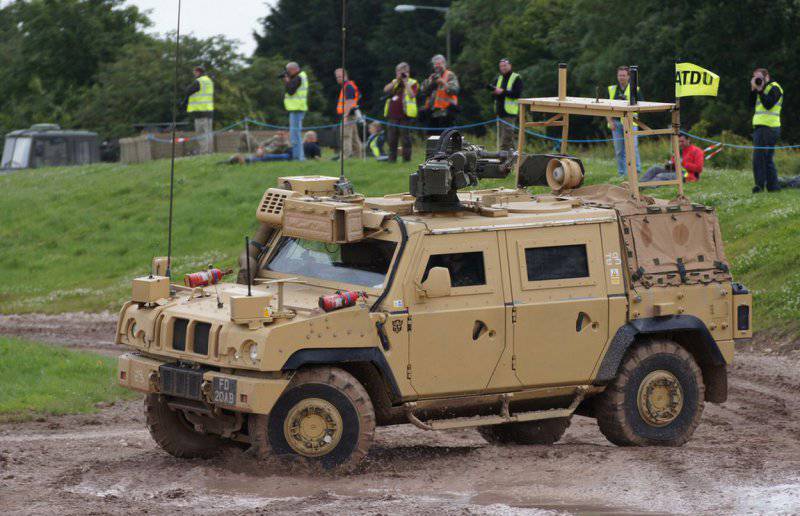
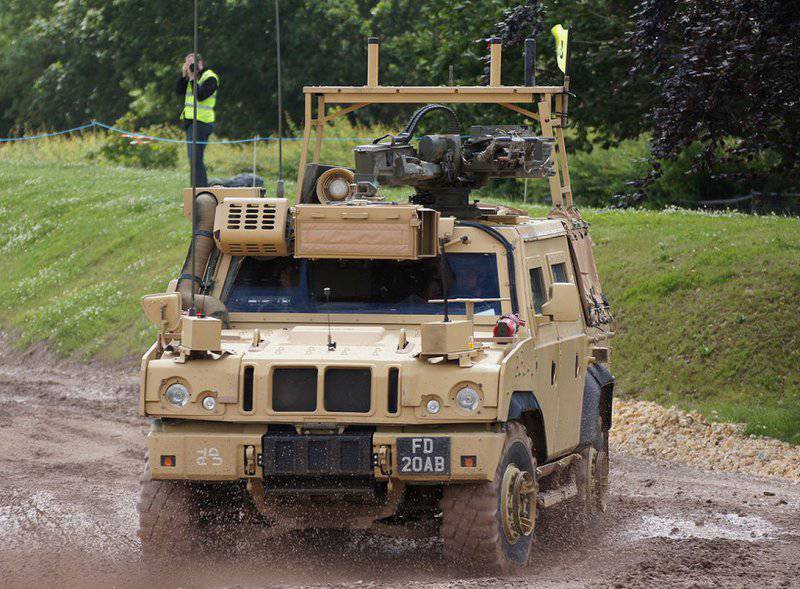
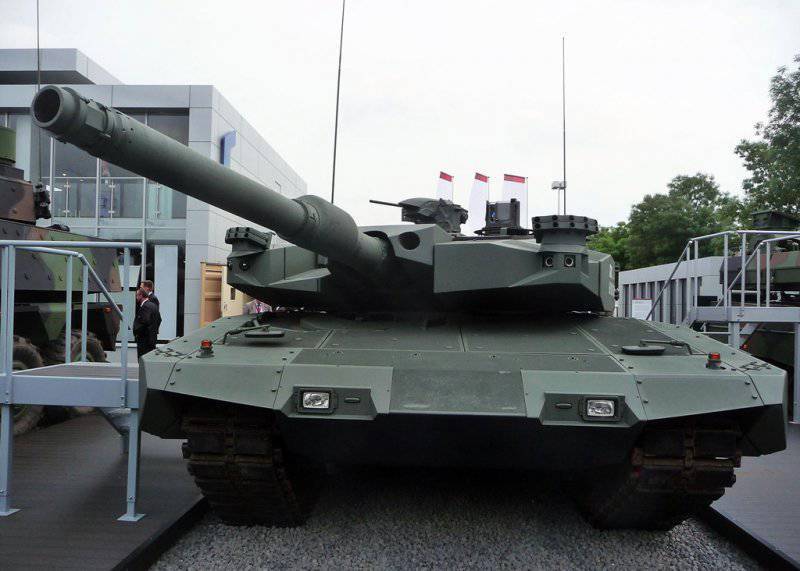
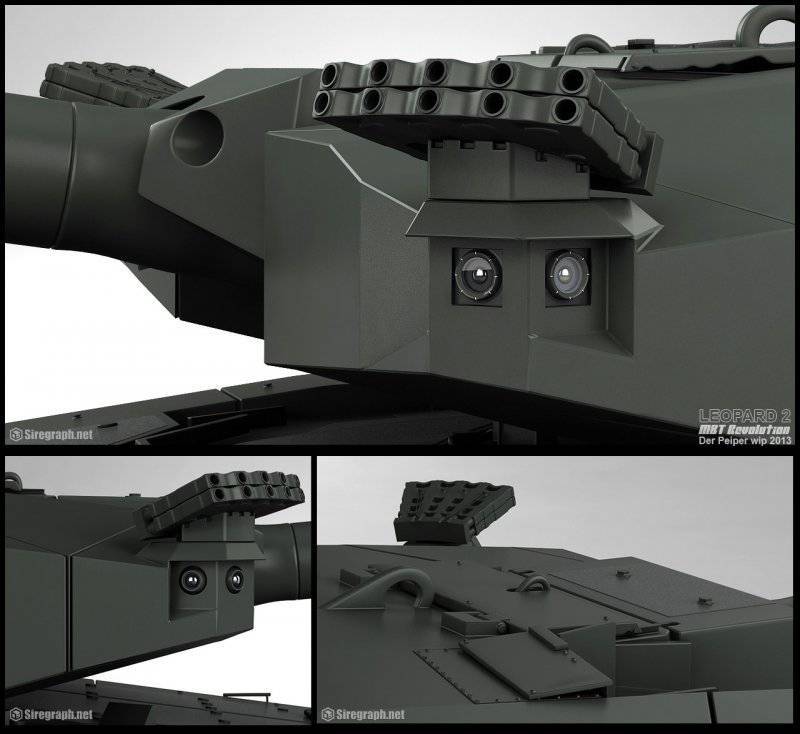
Information